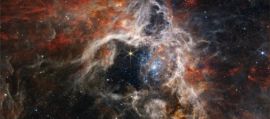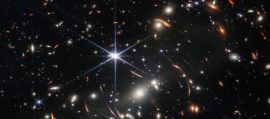Il telescopio spaziale James Webb è completamente dispiegato
Completare con successo l'ultimo grande ostacolo, dispiegando gli specchi, pone le basi per preparare l'osservatorio per le osservazioni
| Richard Brewer |

Illustrazione dei gruppi specchio primario e secondario JWST dispiegati sopra il parasole
USA - Sabato 8 gennaio 2022, 18:17 GMT (1:17 p.m. EST) Il James Webb Space Telescope (JWST o Webb) della NASA ha aperto il suo enorme specchio placcato in oro, il passo finale nel drammatico dispiegamento dell'osservatorio. L'ultima porzione dello specchio di 21 piedi (6,5 metri) si è posizionata completando l'apertura. Tutte le principali fasi di spiegamento strutturale di Webb sono ora complete e l'osservatorio è nella sua configurazione operativa.
Thomas Zurbuchen, capo delle missioni scientifiche della NASA, si è congratulato con il team dicendo: "Abbiamo un telescopio dispiegato in orbita, un magnifico telescopio come il mondo non ha mai visto" ... e la sua controparte dell'Agenzia spaziale europea Antonella Nota ha sottolineato che dopo anni di preparazione, tutto è stato fatto per sembrare "incredibilmente facile.” È davvero un tributo alla dedizione e alla competenza del team che "La sequenza più complessa di dispiegamenti mai tentata in una singola missione spaziale" ha raggiunto i suoi traguardi senza problemi.
Il giorno 14 dopo il lancio, Webb è ora a 108.000 km (673.000 miglia) dalla Terra, avendo completato il 75% della distanza dal suo punto di osservazione al punto di Lagrange L2 e sta navigando a 0,4 km/s (0,24 mi/s).
Il telescopio spaziale più grande, potente e lungimirante mai costruito al mondo fornirà una nuova visione dell'universo primordiale e dovrebbe fare scoperte che cambieranno per sempre la nostra comprensione dell'origine e dello sviluppo di stelle e galassie, nonché trasformeranno la nostra conoscenza di pianeti alieni, sondando le loro atmosfere alla ricerca di segni di abitabilità e potenziale vita.
Le operazioni di apertura dello specchio di Webb sono iniziate il 5 gennaio con lo specchio secondario più piccolo e il treppiede e sono state completate l'8 gennaio con la rotazione e il bloccaggio in posizione dei due elementi primari dello specchio.
Non appena il 4 gennaio l'apertura e il tensionamento del parasole sono stati dichiarati completi, il team Webb ha iniziato a dispiegare lo specchio secondario e il gruppo del treppiede. Lo specchio secondario più piccolo da 2,4 piedi (0,74 metri) dirige la luce riflessa dalla superficie dello specchio primario alla strumentazione di misurazione ed è supportato da un sofisticato treppiede composto da tre montanti leggeri lunghi circa 7,62 metri (25 piedi). La struttura di supporto e lo specchio secondario hanno dovuto dispiegarsi, posizionarsi e bloccarsi in posizione con una tolleranza di soli 1,5 millimetri, operazione che è stata confermata completata il 5 gennaio quando lo specchio secondario è stato agganciato, completamente fissato e bloccato in posizione nella sua posizione estesa posizione.
Venerdì 7 gennaio, il team di ingegneri ha iniziato la fase finale delle principali implementazioni strutturali di Webb: l'apertura delle due ali dello specchio principale. I due pannelli laterali dello specchio principale, ciascuno contenente tre dei 18 segmenti esagonali dello specchio rivestiti in oro, sono stati ripiegati per il lancio e ora sono stati aperti e fissati saldamente in posizione. A partire da venerdì mattina, l'ala dello specchio sul lato sinistro dell'osservatorio è stata ruotata in posizione e bloccata, bloccandola in posizione. Questo è stato seguito il giorno successivo dall'ala dello specchio principale sul lato destro, l'ultimo dei principali schieramenti. L'estensione e il bloccaggio di quest'ala sono stati dichiarati completi alle 18:17 GMT (13:17 EST), l'8 gennaio 2022. La NASA riferisce che il processo di tre mesi per allineare tutte le ottiche del telescopio di Webb in un sistema preciso può ora iniziare.
**************ENGLISH *****************
James Webb Space Telescope is Fully Deployed
Successfully completing the last major hurdle, unfolding the mirrors, sets the stage to prepare the observatory for observations
USA - Saturday, 8 January 2022, 18:17 GMT (1:17 p.m. EST) NASA’s James Webb Space Telescope (JWST or Webb) opened up its huge, gold-plated mirror, the final step in the observatory's dramatic deployment. The last portion of the 21-foot (6.5-meter) mirror swung into place completing the unfolding. All of Webb’s history making major structural deployment stages are now complete and the observatory is in its operational configuration.
Thomas Zurbuchen, chief of NASA’s science missions, congratulated the team saying,”We have a deployed telescope on orbit, a magnificent telescope the likes of which the world has never seen” … and his European Space Agency counterpart Antonella Nota made the point that after years of preparation, everything was made to look “amazingly easy.” It is indeed a tribute to the dedication and competence of the team that "The most complex sequence of deployments ever attempted in a single space mission" has met its milestones with out any problems.
Day 14 after launch, Webb is now 108,000 km (673,000 miles) from Earth having completed 75% of the distance to its observation post at Lagrange point L2 and is cruising at 0.4 km/s ( 0.24 mi/s).
The world's largest, most powerful and far seeing space telescope ever built will provide a new view of the early universe and is expected to make discoveries that will forever change our understanding of the origin and development of stars and galaxies as well as transform our knowledge of alien planets, probing their atmospheres for signs of habitability and potential life.
Webb’s mirror unfolding operations began 5 January with the smaller secondary mirror and tripod assembly and was completed on 8 January with the rotation and locking into position of the two primary mirror elements.
As soon as the Sunshield unfolding and tensioning was declared complete on 4 January, the Webb team began unfolding the secondary mirror and tripod assembly. The smaller 2.4 foot (0.74 meter) secondary mirror directs light reflected from the primary mirror's surface to the measuring instrumentation and is supported by a sophisticated tripod assembly made up of three lightweight struts that are each about 7.62 meters (25 feet) long. The support structure and secondary mirror had to deploy, position, and lock itself into place with a tolerance of only 1.5 millimeters, an operation that was confirmed complete on 5 January when the secondary mirror was latched, fully secured and locked into place in its extended position.
On Friday, 7 January, the engineering team began the final stage of Webb’s major structural deployments: unfolding the two primary mirror wings. The two primary mirror side panels, each holding three of the 18 hexagonal gold-coated mirror segments, were folded back for launch and have now been unfolded and latched securely into place. Beginning Friday morning, the mirror wing on the port (left) side of the observatory was rotated into position and latched, locking it into place. This was followed the next day by the primary mirror wing on the right side, the last of the major deployments. The extension and locking of this wing was declared complete at 18:17 GMT (1:17 p.m. EST), 8 January 2022. NASA reports that the three month process of aligning all of Webb’s telescope optics into a precise system can now commence.























